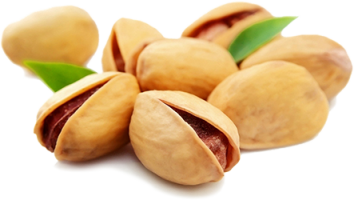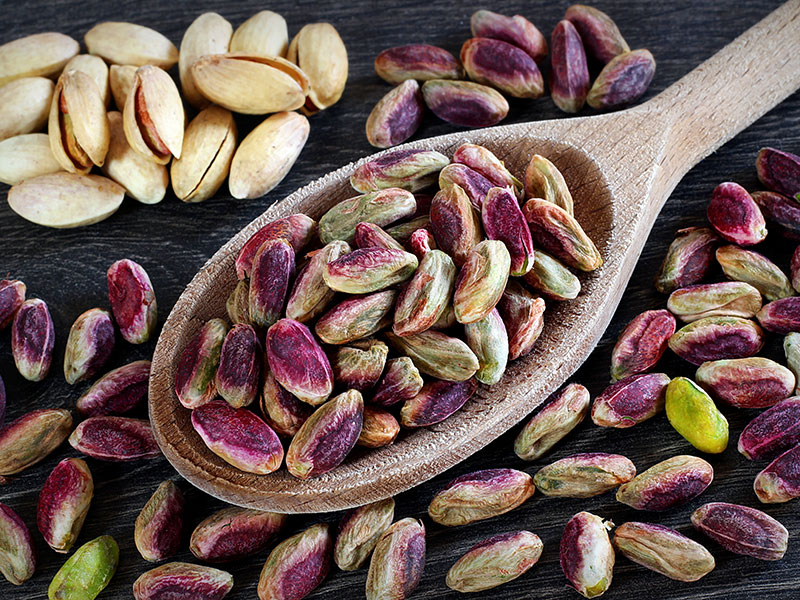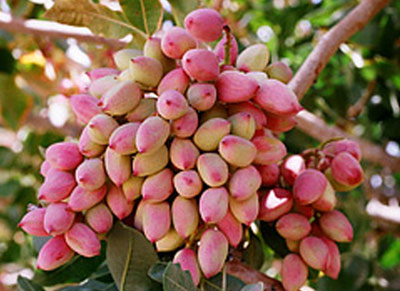
About Pistachio
The pistachio, a member of the cashew family, is a small tree originating from Central Asia and the Middle East.The tree produces seeds that are widely consumed as food. Pistacia vera often is confused with other species in the genus Pistacia that are also known as pistachio. These other species can be distinguished by their geographic distributions (in the wild) and their seeds which are much smaller and have a soft shell
Etymology
The earliest records of pistachio in English are around 1400 with the spellings "pistace" and "pistacia". The word pistachio comes from medieval Italian pistacchio, which is from classical Latin pistacium and ancient Greek pistákion and pistákē (from Middle Persian). In Persian, the word is attested as pesteh.
History
Archaeology shows that pistachio seeds were a common food as early as 6750 BC.
Pliny the Elder writes in his Natural History that pistacia, "well known among us", was one of the trees unique to Syria, and that the seed was introduced into Italy by the Roman Proconsul in Syria, Lucius Vitellius the Elder (in office in 35 AD) and into Hispania at the same time by Flaccus Pompeius.
The early sixth-century manuscript De observatione ciborum ("On the observance of foods") by Anthimus implies that pistacia remained well known in Europe in Late Antiquity. Archaeologists have found evidence from excavations at Jarmo in northeastern Iraq for the consumption of Atlantic pistachio.
The Hanging Gardens of Babylon were said to have contained pistachio trees during the reign of King Merodach-Baladan about 700 BC. The modern pistachio P. vera was first cultivated in Bronze Age Central Asia, where the earliest example is from Djarkutan, modern Uzbekistan. It appears in Dioscurides as pistakia πιστάκια, recognizable as P. vera by its comparison to pine nuts. Additionally, remains of the Atlantic pistachio and pistachio seed along with nut-cracking tools were discovered by archaeologists at the Gesher Benot Ya'aqov site in Israel's Hula Valley, dated to 780,000 years ago. More recently, the pistachio has been cultivated commercially in many parts of the English-speaking world, in Australia, and in New Mexico and California, of the United States, where it was introduced in 1854 as a garden tree.
David Fairchild of the United States Department of Agriculture introduced hardier cultivars collected in China to California in 1904 and 1905, but it was not promoted as a commercial crop until 1929.Walter T. Swingle’s pistachios from Syria had already fruited well at Niles, California, by 1917


Habitat
Pistachio is a desert plant and is highly tolerant of saline soil. It has been reported to grow well when irrigated with water having 3,000–4,000 ppm of soluble salts. Pistachio trees are fairly hardy in the right conditions and can survive temperatures ranging between −10 °C (14 °F) in winter and 48 °C (118 °F) in summer. They need a sunny position and well-drained soil. Pistachio trees do poorly in conditions of high humidity and are susceptible to root rot in winter if they get too much water and the soil is not sufficiently free-draining. Long, hot summers are required for proper ripening of the fruit.

Cultivation
The trees are planted in orchards, and take approximately seven to ten years to reach significant production. Production is alternate-bearing or biennial-bearing, meaning the harvest is heavier in alternate years. Peak production is reached around 20 years. Trees are usually pruned to size to make the harvest easier. One male tree produces enough pollen for eight to 12 drupe-bearing females. Harvesting in the United States and in Greece is often accomplished using equipment to shake the drupes off the tree. After hulling and drying, pistachios are sorted according to open-mouth and closed-mouth shells. Sun-drying has been found to be the best method of drying, then they are roasted or processed by special machines to produce pistachio kernels. In Greece, the cultivated type of pistachios has an almost-white shell, sweet taste, a red-green kernel and a closed-mouth shell relative to the 'Kerman' variety. Most of the production in Greece comes from the island of Aegina, the region of Thessaly-Almyros and the regional units of West Attica, Corinthia and Phthiotis. In California, almost all female pistachio trees are the cultivar 'Kerman'. A scion from a mature female 'Kerman' is grafted onto a one-year-old rootstock.
5 Health Benefits of Pistachios :
1. Cholesterol and Heart Health
A pistachio study published in the American Journal of Clinical Nutrition confirmed the status of pistachios as cholesterol-lowering foods. The researchers studied 28 adults whose LDL cholesterol levels were above the optimal range but were healthy otherwise. The experimental diets included a lower-fat control diet with no pistachios, a healthy diet with one serving of pistachios per day and a healthy diet with two servings of pistachios per day. All participants who ate pistachios lowered their LDL levels. In the context of a heart-healthy diet, the study showed that adding as little as one serving of pistachios per day (10 percent of total energy) lowered LDL cholesterol by 9 percent while the larger daily dose (two servings) of pistachios was attributed to a 12 percent decrease in LDL. High LDL is a major risk factor for coronary heart disease so by lowering your LDL level you can lower your risk of developing serious heart problems like coronary heart disease. Pistachios are also loaded with antioxidants, which are excellent for heart health.


2. Weight Control
Snacking on pistachios can help you to lose weight as well as maintain a healthy weight. By snacking on a serving between meals, the healthy fats, fiber and protein of pistachio nutrition can help you to fend up hunger between meals. Snacking on pistachios can also help you not begin your next meal feeling so ravenous because they help you achieve satiety. Research from the UCLA School of Medicine showed that subjects, who substituted pistachio nuts for food such as candy bars, dairy products, microwave popcorn, buttered popcorn and potato chips, with pistachios accounting for 20 percent of total calories for three weeks, did not gain any bodyweight, lowered their overall cholesterol and increased their good cholesterol.

3.Eye Health
Pistachios are the only nuts that contain a significant amount of the carotenoids known as lutein and zeaxanthin. Dietary carotenoids are believed to provide health benefits to the body by decreasing the risk of disease, particularly certain cancers and eye disease. Lutein and zeaxanthin are the only carotenoids found in the retina and lens of the eye. The results of epidemiological studies suggest that diets rich in lutein and zeaxanthin may help slow the development of age-related macular degeneration and cataracts. Carotenoids are best absorbed with fat in a meal or in the case of pistachio nutrition, good fat is already part of the package, making it easier for the body to absorb pistachio’s lutein and zeaxanthin.
4. Sexual Function
Pistachios have been shown to have a positive effect on men’s sexual vitality. A 2011 study conducted by the Department of 2nd Urology at Atatürk Teaching and Research Hospital in Turkey had subjects consume 100 grams of pistachio nuts at lunch every day for a period of three weeks, which was 20 percent of their daily caloric intake. These subjects were all married men ranging in age from 38 to 59 who had erectile dysfunction (ED) for at least 12 months prior to the study. The men were instructed to maintain similar daily dietary intake, similar physical activity and other lifestyle habits so the only major change was the addition of pistachios to their diets. The results of the study, published in the International Journal of Impotence Research, showed that these men with ED had a significant improvement in erectile function as well as improvement in their serum lipid levels. One reason pistachio nuts likely help ED and work as a natural remedy for impotence is the fact that they’re relatively high in the nonessential amino acid arginine, which appears to maintain flexible arteries and enhance blood flow by boosting nitric oxide, a compound that relaxes blood vessels.
5. Diabetes
A study published in 2015 and conducted at Pennsylvania State University looked at the effects of daily pistachio consumption on the lipid/lipoprotein profile, blood sugar control, inflammation markers and circulation of adults with type II diabetes. Participants either consumed nutritionally adequate diets without pistachios or with pistachios as 20 percent of their daily caloric intake. The results showed that although the pistachio diet didn’t seem to affect glucose control, it did have a positive effect on total cholesterol, cholesterol ratios and triglycerides. Having diabetes puts you at increased risk for heart disease and stroke. For type 2 diabetics looking to improve their cardio metabolic risk factors, eating pistachios regularly as part of a healthy overall diet could help to ward off serious heart issues.

Type of Pistachio
Akbari Pistachio belongs to the long type of Iranian pistachios, it is also known as the most expensive and exclusive type among all Iranian pistachios. One of the characteristics that differentiate this type to the other Iranian pistachios is the height of head and is equal in length.
Akbari pistachios are available in different sizes: 20-22, 22-24, 24-26, and 26-28.


Ahmad Aghaei pistachio is also one of long type of Iranian pistachios and the characteristics of this type can be described as long shape but the lengths size is not always equal.
Ahmad Aghaei pistachios are available in various sizes: 20-22, 22-24, 24-26, 26-28, 28-30, and 30-32.


Badami pistachio is another type of long Iranian pistachios and in terms of length it is shorter than Ahmad Aghaei, and particularly its kernel is very similar to almond.
Badami pistachios are available in the following sizes: 22-24, 24-26, 26-28, 28-30, and 30-32.


Jumbo pistachios are larger and longer compared to round pistachios. Kalleh gouchi pistachio has a long history in cultivation as it’s been growing for more than 4000 years.
Jumbo pistachios are available in the following sizes: 18-20, 20-22, 22-24, 24-26, and 28-30.


This type of pistachio has a round shape and is different from long type pistachios; its length is shorter and smaller compared to other type of pistachios. Fandoghi pistachios are the first type in terms of exportation, due to being reasonable in price.
Fandoghi pistachios are available in the following sizes: 22-24, 24-26, 26-28, 28-30, 30-32, and 32-34.


Plant Origin
A typical serving size of pistachios is one ounce or 49 kernels. Pistachio nutrition is truly impressive. When you consume 1 ounce of raw pistachios, you et the following healthy nutrients thanks to pistachio nutrition:
• 7.7 grams carbohydrates
• 5.7 grams protein
• 12.9 grams fat
• 3 grams fiber
• 0.5 milligram vitamin B6 (25 percent DV)
• 0.3 milligram thiamine (20 percent DV)
• 0.4 milligram copper (20 percent DV)
• 291 milligrams potassium (8.3 percent DV )
• 34 milligrams magnesium (8.5 percent DV)
• 1.1 milligrams iron (6.1 percent DV)
• 0.6 milligram zinc (4 percent DV)
• 14 micrograms folate (3.5 percent DV)
• 30 milligrams calcium (3 percent DV)
• 146 international units vitamin A (2.9 percent DV)
• 1.6 milligrams vitamin C (2.7 percent DV)
• 0.8 milligram vitamin E (2.7 percent DV)
• 0.4 milligram niacin (2 percent DV)

Here are a few interesting facts on pistachios:
• The pistachio was first introduced to the U.S. by the USDA plant exploration service in 1890.
• The pistachio is a relative of the cashew, mango, poison ivy, poison oak, pepper tree and sumac.
• Pistachios grow best in areas that have long, hot, dry summers and moderate winters.
• A pistachio tree takes about 10 to 12 years to produce the first crop.
• Is there such a thing as red pistachios? No, naturally there is no such thing as a red pistachio. Pistachios used to be dyed red to cover shell imperfections and make the nuts more visible in snack machines. Thankfully today, pistachios are rarely dyed red or any other color.
• If you’ve eaten pistachios in their shells, then you’re familiar with the common and frustrating situation of running into a pistachio or two with a closed shell. These are often quite impossible to open with human fingers. Unfortunately, this tightly closed shell is a sign that the nut inside is not fully ripe yet. Pistachios that are ready for consumption have an open shell.
• Pistachios are actually honored with their own day of the year! Every Feb. 26 is National Pistachio Day.
How to Use & Store Pistachios
Pistachios are not seasonal and are available year-round at most grocery and health food stores. High-quality pistachios can be identified by the yellow-green and purple colors of their kernels. It’s a good idea to buy pistachios in their shells because they’ll stay fresher longer. Pistachios within their shells stay fresh for up to one year from their date of production but are best eaten within four months for maximum flavor. Plus, if you buy pistachios in their shells, then you need to do a little work to eat them, which will help you not to overdo it. If pistachio nuts are not stored properly, they absorb moisture from the air and quickly become stale. For maximum freshness, keep pistachios in an airtight container in the refrigerator. Pistachios can be eaten alone or added to all kinds of recipes. They can be kept whole and thrown into a healthy salad or homemade bar, and they can also be crushed and added to smoothies, stir fries, or even used as part of a crust or topping for fish.


